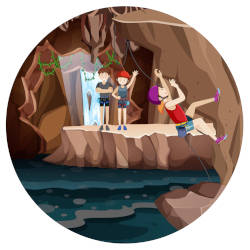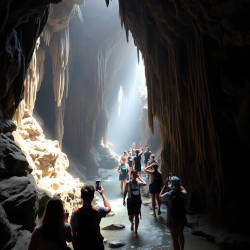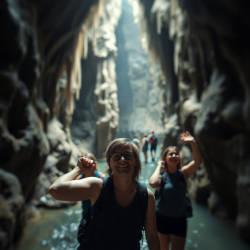Ecotourism
Ecotourism is nature-oriented tourism intended to contribute to the conservation of the natural environment. It has minimal impact and contributes to both nature conservation and environmental education.




Since caves are visited by humans, they are damaged by us. Leaving footsteps, the soot of the fires and light sources, destroyed dripstones, paintings on the wall, and garbage on the floor. This has not changed for at least 30,000 years, so a certain consistency may be assumed. Archaeologists are delighted with the 30,000-year-old remains, but more recent improvements are unanimously rejected. Of course, this is all the more true if they damage or even destroy the historical remains. However, after numerous tourist destinations had problems with those negative side effects of tourism, a sort of anti-movement formed. The idea was to educate the people and then allow them to see spectacular things in a way which harms the environment and the natives as little as possible.
And as always with such things, the more successful it is, the worse the consequences. The point is that fragile ecosystems, for example caves, were opened to a huge number of people. There would be a massive negative impact even in the best cases. But human greed additionally reduced the educative and conservation aspect in favour of extreme sports and fun. Or how would you interpret thousands of people climbing across speleothems? Speleothems are formed by a chemical reaction between water and air which causes the precipitation of limestone in the form of calcite crystals. If someone touches a speleothem, the natural salt and fat on the skin does the same as a drop of oil in water: it covers the whole surface and stops this process. Depending on the water chemistry and the amount of water, it will take months or even years until limestone deposition restarts. And that’s just one example of all the negative effects.
In other words: a group of 5 eco-tourists trampling through a cave are worse than 10,000 visitors in a modern show cave.
This requires an explanation: modern show caves try not to destroy anything. Paths are built from a material that does not react with the cave, carbon fibre, certain plastics or other inert materials. This means that no materials are introduced into or removed from the cave. The paths are built like bridges on feet so that the cave floor is hardly affected and cave animals can move freely underneath as before. The feet only stand on the floor and are not firmly attached; the path can be removed at any time without leaving any residue. Visitors cannot leave the paths, trample on the floor or touch speleothems, and the railing also eliminates the need to hold on to a wall. Modern LED lighting produces hardly any heat and clever placement minimises lamp flora. The only factor that remains is the heat produced by the human body and the carbon dioxide emissions.
Ecotourists, on the other hand, spend hours in the cave instead of 45 minutes. They walk on the floor and trample endemic cave dwellers, trample speleothems on the floor, even climb over stalagmites and frequently touch the walls. There have been numerous cases of them smoking in the cave and throwing the butts away. On longer tours, they eat in the cave, and only if you are very lucky do they not simply throw the packaging into a corner. In addition to heat and carbon dioxide, they release sweat, urine and faeces.
That’s the reason why we created the ecotourism page in the humour section: it’s a joke! And a really bad one at that. It is also often referred to as an oxymoron. And it is getting more and more abstruse: there are certifications for ecotourism, which of course cost money that operators who spend the money on environmental protection and the respective locals cannot afford. The money-makers, who are just riding the wave and using the term wrongly, are of course happy to invest this money. We decided to list those tours if they are called ecotourism or cave trekking, only under certain conditions. In most cases, it’s because it allows us to warn potential customers about the drawbacks.
We have two pages, one for ecotourism and one for cave trekking, although many people may not realise the difference at first glance:
- Cave trekking is when people misuse caves as sports equipment out of a thirst for adventure and cause destruction as a result.
- Ecotourism is when people misuse caves as sporting equipment and cause destruction as a result, but at the same time claim that this is good for the caves, the nature, and the people.
Literature
- Elena Piano, Giuseppe Nicolosi, Stefano Mammola, Valentina Balestra, Benedetta Baroni, Rossana Bellopede, Elena Cumino, Nicola Muzzulini, Anna Piquet, Marco Isaia (2022):
A literature-based database of the natural heritage, the ecological status and tourism-related impacts in show caves worldwide,
Nature Conservation 50, pp 159-174. online DOI
- See also
 Search DuckDuckGo for "Ecotourism danger"
Search DuckDuckGo for "Ecotourism danger" Ecotourism - Wikipedia (visited: 08-MAR-2025)
Ecotourism - Wikipedia (visited: 08-MAR-2025) What Is Ecotourism? (visited: 09-MAR-2025)
What Is Ecotourism? (visited: 09-MAR-2025) Ecotourism (visited: 09-MAR-2025)
Ecotourism (visited: 09-MAR-2025) Knowledge is power: How can we make cave tourism more environmentally friendly? (visited: 09-MAR-2025)
Knowledge is power: How can we make cave tourism more environmentally friendly? (visited: 09-MAR-2025) Ecotourism and health risks (visited: 09-MAR-2025)
Ecotourism and health risks (visited: 09-MAR-2025) Dangers of ecotourism: Up close and infectious (visited: 09-MAR-2025)
Dangers of ecotourism: Up close and infectious (visited: 09-MAR-2025) Ecotourism can put wild animals at risk, scientists say (visited: 09-MAR-2025)
Ecotourism can put wild animals at risk, scientists say (visited: 09-MAR-2025)
 Milne Bay
Milne Bay Monitor Ambiental
Monitor Ambiental Cueva de las Serpientes Colgantes
Cueva de las Serpientes Colgantes
 Index
Index Topics
Topics Hierarchical
Hierarchical Countries
Countries Maps
Maps